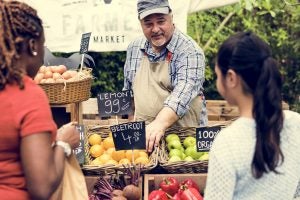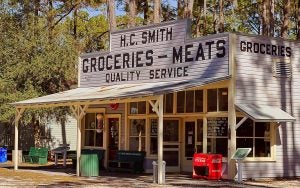My grandmother grew up in the mountains of Tennessee. I learned about her life through the stories she shared. Her father farmed, trapped, and hunted those hills, and he sold the pelts of whatever he had trapped. Whatever was hunted went into the pot or frying pan for dinner that night. She shared these stories with me as a youngster — and I was fascinated. In my mind, my great grandfather was a regular Davy Crockett.
As an adult, I now see the hardships, but I never heard my grandmother complain. It was the way things were done, to survive. Later in life, she and my grandfather had their own farm with vegetables and livestock. I remember visiting during summers. My grandfather would sell vegetables wholesale to local grocers and take the rest to the city market in Indianapolis.
A lot has changed in a generation or two. Refrigeration, transportation, and grocery-chain supply has reinvented both how we eat and the farmers’ relationship with consumers. And I know my grandmother and others in her generation relished those modern conveniences: cake in a box, air conditioning, a tractor that didn’t require hand cranking to start, a good paying job … in town. It made life a little easier. The IGA in Franklin, Indiana, in her eyes, was a modern miracle.
Not everyone feels this way about our food system or the choices we have in modern society when it comes to feeding our families. I attended a local food council meeting a few years back and they had a panel of “experts” — and I use that term lightly, explaining the modern food system. I was humored by their fear of glyphosate and how everything under the sun had been genetically engineered.
The highlight of their discussion was hearing how produce farmers like myself are subsidized to grow Bt sweet corn and GE seedless watermelons. I also found it laughable when the “experts” said that corn, soybean, and wheat farmers choose those crops because the government pays them so much more to grow those crops than they do to grow produce.
Their solution to solving food access? Farmers markets.

Today’s farmers markets are often a reminder of how we used to do things — a sort of nostalgic throwback — but I also see their purpose as slightly different. Craft beer/wine, handmade soaps, and baked treats (for dogs and humans) are wonderful, but they are still artisanal, and the prices are out of reach for many consumers.
Farmers markets are great for entrepreneurs. I know a lot of startups that began at farmers markets and were able to expand their businesses and grow. It’s also a great way to connect people with the farmers who choose direct marketing. We spent several seasons at farmers markets. We sold fruits and vegetables, and my wife would bake and sell pies — lots of them. And they are good, like blue ribbon award-winning good. Many of her customers reminisced about pies their grandmothers made and the wonderful smells that would emanate from their country kitchens. I get it, we should have these outlets to foster direct marketing, and I’m all about supporting local.
And it’s a good thing most of the time. But it’s not everything.
Even the name “farmers market” can be deceiving. Not everyone you buy fruits and vegetables from is a farmer. Some people just throw on overalls (I have never worn those as a farmer), buy a beater pickup truck to “look the part” (we use diesel pickups and reefer box trucks), and always seem to have every fruit and vegetable imaginable regardless of where we are in the season. People also assume how the produce is grown just because it is at a farmers market. It’s obviously organic and “ethically grown,” right? (College Humor did a great video regarding how privileged we can be when talking about “ethical food choices” and farmers markets.)
And little do consumers know how much of the produce sold at markets actually comes from distribution centers, produce brokers, or auctions — and is not grown locally. There have been a few exposés done on the lack of transparency at farmers markets. I don’t share this to disparage hard-working farmers who choose farmers markets as an outlet for their products; I share to remind people that every system has its flaws.
I also work in hunger and food insecurity. Oftentimes folks (some almost flippantly) say, “Well people need to learn to grow their own food.” OK, but people who live in cities and have careers other than agriculture might disagree.
I also hear, “They can just buy straight from a farm or farmers market. That is how we beat Big Ag and change the food system.” What about the 23.5 million Americans who live in food deserts? Or the 35 million Americans who are considered food insecure, which means they are unsure where or how they will get their next meal? That includes 10 million children. What about them? What is their safety net? It is our incredible food system.
Then there’s also, “We need a new food system; then there wouldn’t be any hungry people.” Man, I get so tired of hearing that. Hunger for most people is a symptom of something else, yet our food system produces such an abundance that we, as a country, can easily treat that symptom.
The idyllic food systems that hark back to the turn of the century that local food and slow food advocates often romanticize could not meet those needs today. Slow food advocate Joel Salatin said, “The first supermarket supposedly appeared on the American landscape in 1946. That is not very long ago. Until then, where was all the food? Dear folks, the food was in homes, gardens, local fields, and forests.”
This quote is used by those who advocate for throwing out our current system and starting from scratch. What they and Mr. Salatin both fail to realize is 1) he is wrong about the the year, it was 1916, and 2) there were numerous markets, general stores, butcher shops, and retail food establishments well before then, not to mention that 3) the first meat packers in America date back to 1640.

The food might have been all around, as Salatin stated, but it wasn’t just laying there. You had to possess a very specific skill set to obtain it, and lots of labor went into it. My grandmother shared with me just how much work went into dinner back in the “good ol’ days.”
Is there room for improvement in the food system? Do some things need to change? Of course, but it must be done with perspective and balance. We’ve made so many things better — for farmers, for workers, for the environment and for consumers.
What I do know is that when we talk about the food system or changing the food system, we are speaking from a place filled with modern conveniences. Those conveniences we enjoy today were built by people like my grandfather and grandmother, and my place as a farmer is to pick up where they left off and continue to make it better, help it become more equitable, more robust and continue to evolve, not throw it along with our parents, grandparents and great grandparents’ legacy in laying the foundations of what we have today.
I, for one, am grateful for our modern food system.
Jonathan Lawler operates Brandywine Creek Farms in Indiana and is an advocate for hunger relief and agriculture. He is working on a TV show called Punk Rock Farmer coming in the spring. His motto is FARM OR DIE.



